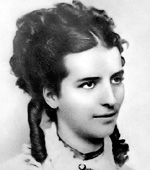Amalie Skram
Amalie Skram (born August 22, 1846 in Bergen as Berthe Amalie Alver, † March 15, 1905 in Copenhagen ) was a Norwegian-Danish writer and suffragette .
Life

Berthe Amalie Alver was born in Bergen on August 22, 1846. The parents owned a small country store , but which may in bankruptcy went when Amalie was 17 years old. Her father Mons Monsen Alver then fled to the United States to avoid jail time and left the mother alone with her five children.
Under pressure from her mother, Amalie agreed to marry Captain Müller, nine years her senior, with whom she traveled the world. After thirteen years of marriage and the birth of two sons, she suffered a nervous breakdown and obtained a divorce after a stay in a mental hospital . Together with her sons she moved to Christiania, today's Oslo , and began to work as a writer. There she also met other Christiania Bohème writers , such as Arne Garborg and Bjørnstjerne Bjørnson , with whom she stayed in contact for years.
In 1884 Amalie Müller married again, this time the Danish writer Erik Skram , with whom she settled in Copenhagen . The marriage produced a daughter. Her duties as a housewife, mother and writer, as well as the weak public response to her literary work, led to another breakdown in 1894, as a result of which Amalie Skram lived in a psychiatric clinic near Roskilde . In 1899 the second marriage was divorced. She died six years later.
Literary career
In 1882 Amalie Skram made her debut under the name Amalie Müller with the story Madam Høiers Leiefolk . Her first novel, Constance Ring, followed three years later . She wrote other novels and short stories that can be divided into three categories:
- Married novels
These include Constance Ring , Lucie , Fru Ines and Forraadt , who deal with the role of women in marriage and, above all, female sexuality , a taboo subject at the time. Their work was often perceived as provocations and sparked protests.
- Generational novels
Amalie Skram's main work, the four-volume series Hellemyrsfolket , deals with the fate of an entire family over several generations. Similar to the married novels, the generational novels are also strongly influenced by naturalism and denounce the social grievances of the time.
- Mental hospital novels
Amalie Skram settled her last two works Paa St. Jørgen and Professor Hieronimus in her living environment at the time, the mental hospital. These novels, too, caused quite a stir in Denmark and brought improvements in the institutions.
Common to all works is the naturalistic approach and the will to bring about social change. Skram's work therefore belongs to the so-called tendency literature . The emphatically feminine view of many problems of the time made Amalie Skram a key witness of the women's movement in early European modernism . Her works, although forgotten today as a whole, received more attention from feminism and gender studies from the 1960s onwards .
Works
- Novels
- Constance Ring , 1885
- Lucie , 1888, love story between the lawyer Gerner and a dancer from Tivoli
- Fru Inez , 1891
- Forraadt , 1892
- Hellemyrsfolket:
- Sjur Gabriel , 1887
- SG Myhre , 1890
- Afkom , 1898
- Professor Hieronimus , 1895 (German: in one volume with Paa St. Jørgen ): Translated by Christel Hildebrandt , afterword by Gabriele Haefs . Berlin, Guggolz Verlag 2016, ISBN 978-3-945370-07-0 .
- Paa St. Jørgen , 1895
- Mennesker , 1905 (unfinished)
- Novellas
- Børnefortellinger , 1890
- Kjærlighed i Nord og Syd , 1891
- Summer , 1899
- Plays
- Agnete , 1893 (German: edited by Therese Krüger and Otto Erich Hartleben . Berlin, German writers' cooperative 1895).
literature
- Liv Køltzow : The young Amalie Skram. Et portrett fra det nittende århundre . Gyldendal, Oslo 1992, ISBN 82-05-31342-3 .
- Irene Engelstad, Liv Køltzow, Gunnar Staalesen : Amalie Skrams verden. Gyldendal, Oslo 1996, ISBN 82-05-24337-9 .
Web links
- Works by Amalie Skram in the Gutenberg-DE project
- About life and work in Swedish
- Impassioned Naturalism English analysis and classification of their works
- that. in Danish
- Overview of the University of Tromsø
| personal data | |
|---|---|
| SURNAME | Skram, Amalie |
| ALTERNATIVE NAMES | Alver, Berta Amalie (maiden name) |
| BRIEF DESCRIPTION | Norwegian-Danish writer and women's rights activist |
| DATE OF BIRTH | August 22, 1846 |
| PLACE OF BIRTH | Bergen (Norway) |
| DATE OF DEATH | March 15, 1905 |
| Place of death | Copenhagen |
